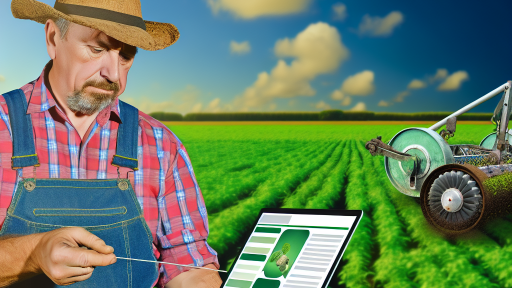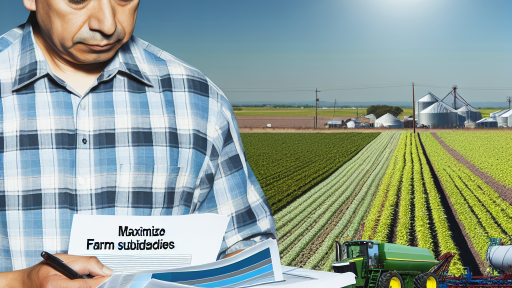Overview of Agricultural Subsidies
Definitions
Agricultural subsidies refer to financial support from the government.
These funds aim to stabilize farmers’ incomes and encourage production.
Subsidies help maintain food prices and ensure food security.
Furthermore, they can promote environmental stewardship.
Types of Agricultural Subsidies
Subsidies take various forms, each serving different purposes.
Direct payments are common, providing farmers with cash assistance.
Price supports guarantee a minimum price for specific crops.
Crop insurance helps mitigate the risk of poor harvests.
Additionally, conservation programs incentivize sustainable farming practices.
Direct Payments
Direct payments provide farmers with predictable income support.
They are usually determined by historical production levels.
This type of subsidy is beneficial during volatile market conditions.
Price Supports
Price supports ensure that farmers receive a minimum price for their products.
This protects them from drastic price fluctuations in the market.
Consumers may face higher prices, but it stabilizes the agricultural sector.
Transform Your Agribusiness
Unlock your farm's potential with expert advice tailored to your needs. Get actionable steps that drive real results.
Get StartedCrop Insurance
Crop insurance safeguards farmers against unexpected losses.
It covers damages from natural disasters or market declines.
This type of support encourages farmers to take risks on new crops.
Conservation Programs
Conservation programs promote environmentally sustainable practices.
They encourage farmers to protect natural resources and biodiversity.
Subsidies in this area may cover costs for implementing eco-friendly techniques.
Recent Changes in Agricultural Subsidy Policies
Introduction to Policy Changes
New agricultural subsidy policies aim to support farmers effectively.
These changes result from evolving market conditions and environmental concerns.
Farmers must stay informed to take advantage of these adjustments.
Key Updates in Subsidy Programs
The government recently revamped existing subsidy programs.
Now, direct payments target small-scale farmers more than before.
Additionally, crop insurance programs have been expanded significantly.
This allows farmers to better manage risks associated with natural disasters.
Focus on Sustainability
New policies emphasize sustainable farming practices.
Farmers who implement eco-friendly methods now receive higher subsidies.
This change encourages a shift towards organic farming and renewable resources.
Application Processes and Requirements
The application process has become more streamlined and accessible.
Farmers can now apply online, reducing paperwork significantly.
However, they must meet specific guidelines to qualify for the new programs.
Outlook for Future Subsidies
Looking ahead, agricultural subsidies will likely continue evolving.
Government officials will adjust programs based on farmer feedback and market trends.
Thus, ongoing communication between farmers and policymakers is essential.
Implications of Agricultural Policy Changes
Understanding these recent changes can empower farmers.
By staying informed, farmers can maximize their benefits from subsidies.
Showcase Your Farming Business
Publish your professional farming services profile on our blog for a one-time fee of $200 and reach a dedicated audience of farmers and agribusiness owners.
Publish Your ProfileThis proactive approach ensures their financial stability and sustainability.
Impact of Agricultural Subsidies on Small vs. Large Farms
Overview of Agricultural Subsidies
Agricultural subsidies play a crucial role in the farming industry.
They support farmers by stabilizing prices and income.
Subsidies come in various forms, including direct payments and crop insurance.
These financial aids aim to enhance productivity and ensure food security.
Benefits for Small Farms
Small farms often rely heavily on subsidies for survival.
These funds can cover essential operational costs.
Subsidies can enable small farmers to invest in sustainable practices.
They also provide a buffer against volatile market conditions.
Many small farmers depend on programs tailored to their scale of operations.
Access to Resources
Subsidies help small farmers gain access to necessary resources.
Thus, they can purchase seeds, fertilizers, and equipment more easily.
Furthermore, subsidies can support participation in cooperative programs.
This collaboration boosts their bargaining power in the market.
Advantages for Large Farms
Large farms also benefit from agricultural subsidies, but in different ways.
They can leverage subsidies to expand their operations significantly.
Consequently, larger farms often achieve economies of scale.
These funds allow for investment in advanced technology and infrastructure.
Market Influence
Large farms can influence market prices due to scale.
Subsidies increase their profit margins, enabling lower prices.
This practice can create challenges for smaller competitors in the market.
As a result, the balance of competition in agriculture shifts.
Challenges Faced by Small Farms
Despite the benefits, small farms face challenges with subsidies.
Access to information about available subsidies can be limited.
Additionally, application processes may be complex and time-consuming.
This complexity can discourage small farmers from pursuing support.
Challenges Faced by Large Farms
Large farms also encounter challenges concerning subsidies.
There is often scrutiny over the fairness of subsidy distribution.
Large farms may face regulatory pressures as well.
These pressures can stem from public concern about food systems.
Future of Agricultural Subsidies
The future landscape of agricultural subsidies is evolving.
Changes in policy may lead to more equitable distribution of funds.
New initiatives could focus on promoting environmental sustainability.
Farmers should stay informed about upcoming developments.
Delve into the Subject: How to Apply for Farm Subsidies Successfully
Application Process for Farmers: Eligibility and Requirements
Understanding Eligibility
Eligibility for agricultural subsidies varies by program.
Farmers should review specific guidelines for each subsidy.
Typically, factors include farm size, type of crops, and income levels.
Local agricultural departments often provide detailed information.
Gathering Required Documentation
Farmers must collect various documents before applying.
Showcase Your Farming Business
Publish your professional farming services profile on our blog for a one-time fee of $200 and reach a dedicated audience of farmers and agribusiness owners.
Publish Your ProfileThese might include tax returns, income statements, and business plans.
Proving land ownership or lease agreements is also essential.
Moreover, farmers should prepare records of past crop yields.
Compiling Application Forms
Once documentation is ready, farmers can begin filling out application forms.
Applications are usually available online or at local offices.
Accurate completion is vital to avoid delays in processing.
Farmers should double-check all entries for correctness.
Submitting Applications
After completing the application, submission follows.
Farmers can often submit applications electronically or via mail.
Be mindful of deadlines to ensure timely processing.
It’s wise to confirm receipt of the application with the office.
Awaiting Approval and Follow-Up
After submission, farmers must wait for approval notifications.
Processing times can vary, depending on the program and demand.
Farmers should stay in touch with the local agency for updates.
If denied, understanding the reasons can help in future applications.
You Might Also Like: Understanding Agricultural Financial Aid Options
Common Misconceptions About Agricultural Subsidies
Myth: Subsidies Only Benefit Large Farms
Many believe that agricultural subsidies solely support large farms.
In reality, small farms also benefit significantly from these programs.
This support helps them remain competitive in the market.
Myth: Subsidies Create Dependency
Some argue that subsidies create dependency among farmers.
However, these funds often help farmers stabilize their income.
They allow farmers to invest in sustainable practices and technologies.
Myth: Subsidies Are Ineffective
Many people think subsidies do not achieve their intended goals.
In fact, they play a critical role in ensuring food security.
Moreover, they help maintain fair prices for consumers.
Myth: All Subsidies Are the Same
Another misconception is that all subsidies operate in similar ways.
Subsidies can vary widely in type and purpose.
For instance, some focus on crop insurance while others aim to support conservation efforts.
Myth: Subsidies Are the Main Factor in Agriculture
Some believe that subsidies are the primary driver of agricultural success.
While they are important, many other factors influence farming outcomes.
Weather conditions, market demand, and labor availability also play crucial roles.
Myth: All Subsidies Are Negative for the Environment
Many think that subsidies cause environmental harm.
On the contrary, some subsidies incentivize sustainable farming practices.
These funds can support initiatives aimed at protecting natural resources.
See Related Content: Benefits of Government Aid for Farmers

Financial Implications
Understanding the Role of Subsidies
Agricultural subsidies play a significant role in farming profitability.
They provide financial support to offset costs and reduce risk.
Farmers rely on these funds to maintain their operations during tough times.
Subsidies can influence the market by increasing supply and stabilizing prices.
Impact on Profitability
Profitability varies for different types of agricultural operations.
Showcase Your Farming Business
Publish your professional farming services profile on our blog for a one-time fee of $200 and reach a dedicated audience of farmers and agribusiness owners.
Publish Your ProfileCrops, livestock, and specialty farms each experience different benefits.
In many cases, subsidies directly enhance profit margins for farmers.
They allow farmers to invest in better technology and practices.
Increased investments lead to higher yields and quality products.
Types of Subsidies
Farmers can access various types of subsidies.
Direct payments are one of the most common forms.
These payments provide guaranteed income irrespective of market conditions.
Additionally, crop insurance programs protect against losses from unforeseen events.
Price support programs help maintain stable market prices for essential crops.
Long-term Financial Planning
Farmers should consider subsidies in their long-term financial strategies.
Relying solely on subsidies can be risky in changing political climates.
Diversifying income sources can create a more stable financial environment.
Investing in sustainability can lead to eligibility for additional grants.
Overall, knowing about subsidies aids in better financial management.
Risks and Challenges
While subsidies offer significant support, challenges exist.
Changes in government policy can impact subsidy availability.
Furthermore, reliance on subsidies can lead to complacency in management practices.
Farmers must stay informed about shifts in subsidy programs.
Ultimately, understanding these factors is crucial for sustained success.
See Related Content: Navigating Grants and Loans for Farmers
Case Studies: Successful Utilization of Subsidies by Farmers
Innovative Crop Diversification
Emily Johnson, a farmer from Iowa, embraced crop diversification.
She utilized agricultural subsidies to introduce organic soybeans.
This shift resulted in increased yield and profit margins.
Additionally, it reduced dependency on corn and wheat.
Subsidies helped cover the initial cost of organic certification.
Technological Advancements in Farming
Mark Stevens, a farmer in California, invested in precision agriculture.
He received financial support through federal subsidies.
This technology optimized water use and fertilizer application.
Consequently, Mark witnessed a significant reduction in costs.
His production levels doubled within two years.
Community Supported Agriculture (CSA) Initiatives
Linda Garcia launched a CSA program in Texas.
With the help of state subsidies, she established a robust customer base.
This initiative promoted local produce and sustainability.
Furthermore, Linda strengthened community ties through farm events.
Subsidies allowed her to invest in marketing and education.
Livestock and Sustainable Practices
David Thompson focused on sustainable livestock practices.
He accessed subsidies for pasture improvement projects.
This enhanced animal welfare and reduced feed costs.
As a result, his herd health improved considerably.
David also gained certifications that boosted marketability.
Showcase Your Farming Business
Publish your professional farming services profile on our blog for a one-time fee of $200 and reach a dedicated audience of farmers and agribusiness owners.
Publish Your ProfileRealizing Climate Resilience
Rachel Kim implemented climate-resilient farming techniques.
She utilized subsidies to incorporate cover cropping systems.
This practice improved soil health and moisture retention.
Consequently, Rachel diminished the effects of droughts.
Her farm became a model for sustainable agriculture in her region.
Future Trends in Agricultural Subsidies: What to Expect
Increased Focus on Sustainability
Future agricultural subsidies will prioritize sustainability.
Farmers will receive incentives for eco-friendly practices.
This shift aims to promote environmental stewardship.
Increased funding for organic farming programs is likely.
Consequently, traditional farming methods may receive less support.
Technological Advancements in Farming
Technological integration will shape future agricultural subsidies.
Farmers adopting precision agriculture will benefit significantly.
Subsidies will support the acquisition of advanced machinery.
Funding for data analysis tools will become more common.
Such tools improve efficiency and crop yield.
Enhanced Risk Management Programs
Expect improved risk management programs in the coming years.
These programs will help farmers mitigate financial losses.
Especially important is support for climate-related risks.
Subsidies will encourage diversification of crops to reduce risks.
Grants for insurance or disaster relief will also expand.
Focus on Local and Regional Food Systems
Future trends may include a boost for local food systems.
Subsidies will aim to strengthen local food production chains.
Farmers engaging in community-supported agriculture will receive incentives.
This approach enhances food security and local economies.
Consequently, farmers may focus more on direct-to-consumer sales.
Global Market Influences on Subsidies
Global market trends will impact domestic agricultural subsidies.
Farmers must stay informed about international trade agreements.
Changes in foreign markets may affect subsidy allocations.
Moreover, competition from imported goods could influence strategies.
Farmers need to adapt to these evolving market dynamics.




